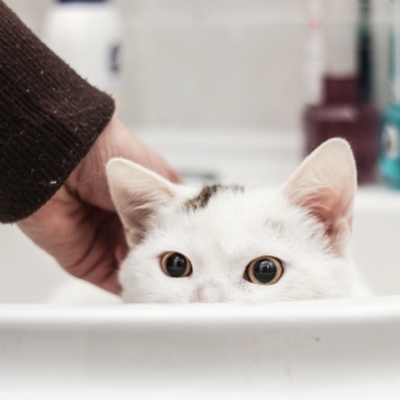Training A Cat To Use A Litter Box:
Summary:
Teaching newborn kitten to use a litter box is fairly straight forward. They have an instinctual knowledge that bowel and bladder elimination must be deposited in a hole dug in the earth and then covered up. If you have just adopted an adult cat and want to train her to use the litter box, patiently start from the beginning.


Kitten and the Litter Box
Each newborn kitten comes with the instinctual knowledge that bowel and bladder elimination must be deposited in a hole dug in the earth and then covered up.
All that one needs to do to train a kitten is to provide the earth and show the kitten where it is. The kitten will take care of the rest!
Start out with a litter box large enough to accommodate your cat as an adult. This eliminates the need to change boxes which can sometimes be a factor in its future disuse. Pour in an absorbent cat-box filler about three to four inches deep. I like a scented filler that does not have a lot of fine powder in it. The new powdered clay fillers are very good. The advantage to using powdered clay is that you remove only the balls of matter each day and replace the lost litter occasionally. If you use regular filler, clean it every day, and completely change it every three or four days.
It is important to place the litter box in a semi-private location such as under a table or inside a closet with the door partially open. Cats like their privacy.
As soon as you bring your kitten home, show her the location of the litter box by placing her in it. She will probably jump out immediately. That's okay. Several times those first few days, place her in the litter box. She will soon find out that that is the only place where she will be able to dig a hole for elimination purposes. For the first several days, every time she does get into the litter box, praise her with "Good Kitty!"
If your kitten does not use the litter box after this procedure, have her thoroughly checked over by a veterinarian. If she is healthy, but still insists on going in places other than the litter box, clean these areas with soap and water and then overspray them with a solution of 25 percent white vinegar mixed with 75 percent water. This will remove the ammonia smell which might encourage her to go back to these same spots. If she is returning to the same spot, place the litter box there. If this does not work, confine her to one room, such as bathroom, for a week. Place her food, water, and bed in one end of the room and her litter box in the other. Once she has started using it again, you can let her roam freely.
Adult Cat and the Litter Box
If you have just adopted an adult cat and want to train her to use the litter box, start from the beginning, following the instructions above. If you are the guardian of an adult cat who has stopped using the litter box, then look for medical or behavioral causes. Fortunately, most behavioral litter box problems are self-correcting. It usually requires confining the cat to a single room with her bed, food, and water at one end, and the litter box at the other. The cat will begin using the litter box within a few days. Before trying this extreme measure, however, consider the many conditions which will cause a cat to quit using the box. These conditions must be altered if a permanent change is desired.
The first problem to consider is the medical one. If your cat is defecating out of the litter box, consider having her checked for blocked anal glands. If she is constantly licking in the anal area, scooting along the floor, or crying, see a veterinarian. A cat may also have diarrhea which may be causing feces to stick to her fur and drop off later outside of the box. Diarrhea may be caused by an improper diet, hairballs, parasites, eating spoiled food, or an illness. If you suspect any of these as the problem, see a veterinarian.
Indiscriminate urination can be caused by a bladder infection, diabetes, old age incontinence, or arthritis. Some of the symptoms to look for besides urination outside of the box are: increased frequency of urination, decreased volume of urine, increased thirst, crying, obvious distress during urination, enlarged abdomen, and blood in the litter box. Of course, any change of personality is a possible sign of illness. See a veterinarian immediately if you suspect a bladder blockage. This is a life threatening situation!
There are many factors to consider if your cat's discontinued use of the litter box is a behavioral problem. Changing the brand of litter or the size, shape, and depth of the litter box can cause some cats to refuse its use. If you have just adopted an adult cat, this could be her problem until she becomes accustomed to the new litter and box. Experiment first with litter box filler. Then try a different litter box.
The stress is tremendous to a new adoptee going from her old familiar territory, then to a shelter, and now to your home. It takes a cat from three to eight weeks to become fully adjusted to a new environment, and this includes consistent use of the litter box. Be patient, and do not punish your cat by hitting her, rubbing her nose in the feces or urine, or scolding her. Cats are very clean by nature and the last thing a cat wants is to soil her territory outside of her toilet. A cat knows what a litter box is for, and she knows how to hit that tiny little target hole that she just created!
The anxiety of being given up for adoption can cause some cats to release stress by defecating or urinating wherever they feel secure, and it may not be in that brand new litter box.
Cats will discontinue using a litter box that is full. It is best to clean it daily. With more than one cat, it is a good idea to have a litter box for each.
A new adoptee might be accustomed to going in a box that has shredded paper, sand, sawdust, powdered clay, or some other substrate. Experiment with different substrates. The depth of the substrate can be a critical factor for some cats. Some like it deep, some shallow. If your cat urinates on a certain rug, cut out a piece of rug, place it in the litter box along with some litter, and gradually reduce the size of the piece of rug while at the same time increasing the amount of litter. If your cat is urinating on a cold surface like the stove top or sink, see a veterinarian. This could be a medical problem.
If you have just moved into a new home, and your cat started urinating outside of the box, you might suspect the mastic used on some tiles and carpets. Some have an ammonia smell, which is the odor of urine, encouraging some cats to urinate on these surfaces. You might also suspect that the previous owners had a cat who missed the litter box.
If your cat has an accident, say nothing, clean it up, and spray over it with a 25 percent white vinegar and 75 percent water solution. This will mask the ammonia odor and discourage kitty from returning to the same spot again.
Some cats can be stressed enough to temporarily discontinue using the litter box if a new baby, pet, or significant other moves into the home. The loss of a significant other, including a companion animal pet, can temporarily break a cat's litter box routine. These problems are usually self-correcting.
Cats like their litter boxes placed in a semi-private location. Inside a closet with the door slightly open or under a table away from the main traffic pattern are good places. I know one person who keeps it in the shower stall. Experiment with locations. Put the box in a place that seems comfortable to your cat.
Any disturbance in a cat's routine or change in her territory, such as remodeling or painting, may cause her to temporarily discontinue use of the litter box. It is important not to feed table scraps to a cat. Feed her a quality food. If irregular eating habits are creating house soiling problems, feed her twice a day and put the food away to eliminate in-between snacking. This would also benefit an overweight cat.
Remember, do not punish a cat for any behavior problems. A cat views chasing, kicking, hitting, and screaming as punishment. Physical punishment creates stress which can result in litter box problems.

